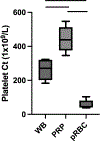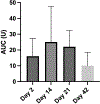Direct red blood cell effect on thrombosis is dependent on the interaction of tissue factor and calcium with membrane phosphatidylserine
- PMID: 38605437
- PMCID: PMC11199102
- DOI: 10.1097/TA.0000000000004340
Direct red blood cell effect on thrombosis is dependent on the interaction of tissue factor and calcium with membrane phosphatidylserine
Abstract
Background: Prior literature has implicated red blood cells (RBCs) in the initiation of thrombosis and suggests that posttransfusion hypercoagulability may occur secondary to the effects of RBCs. Elevated serum tissue factor is a known sequelae of acute trauma. Phosphatidylserine (PS) is a prothrombotic phospholipid present within the RBC cell membrane. We hypothesized that RBC aggregation is dependent on the interaction between RBC membrane bound (exposed) PS, extracellular calcium, and tissue factor.
Methods: Human whole blood (WB) was separated into components, including RBCs and platelet-rich plasma (PRP). Whole blood, PRP, and RBCs underwent impedance aggregometry utilizing arachidonic acid (AA), ADP, collagen, calcium, and tissue factor (TF)-based agonists. Red blood cells then underwent impedance aggregometry utilizing combined calcium and TF agonists. Red blood cells were pretreated with Annexin V, a known PS blocking agent, and underwent impedance aggregometry with combined calcium and TF agonists to determine if the mechanism of calcium/TF-induced RBC aggregability is dependent on PS. Red blood cells treated with calcium, TF, calcium+TF, and pre-treated with Annexin V followed by calcium+TF were perfused through an in vitro model of pulmonary microcirculatory flow.
Results: Red blood cell aggregation was significantly higher than that of WB and PRP when utilizing a TF agonist, an effect unique to TF. The combination of calcium and TF demonstrated significantly higher RBC aggregation than either agonist alone. Pretreatment with Annexin V resulted in a significantly reduced aggregability of RBC following treatment with TF + calcium. Red blood cells aged to 42 days did not exhibit significant change in aggregation. Exposure to calcium and TF significantly reduced time to thrombosis of RBCs perfused through a pulmonary microcirculatory model.
Conclusion: Treatment with both TF and calcium synergistically induces RBC aggregation. Phosphatidylserine appears to play an integral role in the TF/calcium-based, age-independent RBC aggregation response. Red blood cells treated with TF + calcium exhibit more rapid thrombus formation in an in vitro model of pulmonary microcirculatory perfusion.
Copyright © 2024 Wolters Kluwer Health, Inc. All rights reserved.
Conflict of interest statement
Figures






Similar articles
-
Red blood cell entrapment in thrombi formed under pathological flow: Stiffness and binding antigens impact thrombus morphology and cell distribution.Acta Biomater. 2025 Jul 1;201:336-346. doi: 10.1016/j.actbio.2025.05.055. Epub 2025 May 23. Acta Biomater. 2025. PMID: 40414266
-
Thrombin generation and cell-dependent hypercoagulability in sickle cell disease.J Thromb Haemost. 2016 Oct;14(10):1941-1952. doi: 10.1111/jth.13416. Epub 2016 Aug 31. J Thromb Haemost. 2016. PMID: 27430959
-
Protective effect of hydroxytyrosol against hyperglycemia-induced phosphatidylserine exposure in human erythrocytes: focus on dysregulation of calcium homeostasis and redox balance.Redox Biol. 2025 Sep;85:103783. doi: 10.1016/j.redox.2025.103783. Epub 2025 Jul 21. Redox Biol. 2025. PMID: 40700934 Free PMC article.
-
Transfusion thresholds for guiding red blood cell transfusion.Cochrane Database Syst Rev. 2021 Dec 21;12(12):CD002042. doi: 10.1002/14651858.CD002042.pub5. Cochrane Database Syst Rev. 2021. PMID: 34932836 Free PMC article.
-
Restrictive versus liberal red blood cell transfusion strategies for people with haematological malignancies treated with intensive chemotherapy or radiotherapy, or both, with or without haematopoietic stem cell support.Cochrane Database Syst Rev. 2017 Jan 27;1(1):CD011305. doi: 10.1002/14651858.CD011305.pub2. Cochrane Database Syst Rev. 2017. Update in: Cochrane Database Syst Rev. 2024 May 23;5:CD011305. doi: 10.1002/14651858.CD011305.pub3. PMID: 28128441 Free PMC article. Updated.
References
-
- Davis DT, Johannigman JA, Pritts TA. New strategies for massive transfusion in the bleeding trauma patient. J Trauma Nurs Off J Soc Trauma Nurses. 2012;19(2):69–75. - PubMed
-
- Holcomb JB, Jenkins D, Rhee P, Johannigman J, Mahoney P, Mehta S, et al. Damage control resuscitation: directly addressing the early coagulopathy of trauma. J Trauma. 2007;62(2):307–310. - PubMed
-
- Como JJ, Dutton RP, Scalea TM, Edelman BB, Hess JR. Blood transfusion rates in the care of acute trauma. Transfusion (Paris). 2004;44(6):809–813. - PubMed
-
- Baker JE, Niziolek GM, Elson NC, Pugh AM, Nomellini V, Makley AT, et al. Optimizing Lower Extremity Duplex Ultrasound Screening After Traumatic Injury. J Surg Res. 2019;243:143–150. - PubMed
MeSH terms
Substances
Grants and funding
LinkOut - more resources
Full Text Sources
Medical
Research Materials
Miscellaneous

